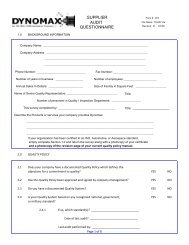You also want an ePaper? Increase the reach of your titles
YUMPU automatically turns print PDFs into web optimized ePapers that Google loves.
Environmental Factors: The enemies of electronic components are well known. Heat, moisture,<br />
vibration and dirt are chief among them and obviously should be mitigated. Drives are rated for<br />
operation in specific maximum and minimum ambient temperatures. If the maximum ambient is<br />
exceeded, extra cooling must be provided, or the drive may have to be oversized. High altitudes,<br />
where thinner air limits cooling effectiveness, call for special consideration. Ambient<br />
temperatures too low can allow condensation. In these cases, or where humidity is generally<br />
high, a space heater may be needed.<br />
Drive enclosures should be selected based on environment. NEMA I enclosures are ventilated and<br />
must be given room to "breath." NEMA 4/12 enclosures, having no ventilation slots, are intended<br />
to keep dirt out and are also used in washdown areas. Large heat sinks provide convection<br />
cooling and must not be obstructed, nor allowed to become covered with dirt or dust. Higherhorsepower<br />
drives are typically supplied within NEMA-rated enclosures. "Sub-micro" drives, in<br />
particular, often require a customer-supplied enclosure in order to meet NEMA and National<br />
Electrical Code standards. The enclosures of some "micro" drives, especially those cased in<br />
plastic, may also not be NEMA-rated.<br />
Motor Considerations With AC Drives<br />
One drawback to pulse width modulated drives is their tendency to produce voltage spikes,<br />
which in some instances can damage the insulation systems used in electric motors. This<br />
tendency is increased in applications with long cable distances (more than 50 feet) between the<br />
motor and drive and with higher-voltage drives. In the worst cases, the spikes can literally "poke<br />
a hole" into the insulation, particularly that used in the motor's windings. To guard against<br />
insulation damage, some manufacturers now offer inverter-duty motors having special insulation<br />
systems that resist voltage spike damage. <strong>Part</strong>icularly with larger drives, it may be advisable to<br />
install line reactors between the motor and drive to choke off the voltage spikes. In addition,<br />
some increased motor heating will inevitably occur because of the inverter's "synthesized" AC<br />
waveform. Insulation systems on industrial motors built in recent years can tolerate this, except<br />
in the most extreme instances. A greater cooling concern involves operating for an extended<br />
time at low motor RPM, which reduces the flow of cooling air, especially in constant torque<br />
applications where the motor is heavily loaded even at low speeds. Here, secondary cooling may<br />
be required.<br />
- 24 -



